Supergiant - Study guides, Class notes & Summaries
Looking for the best study guides, study notes and summaries about Supergiant? On this page you'll find 48 study documents about Supergiant.
Page 2 out of 48 results
Sort by
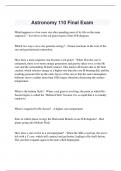
-
Astronomy 110 Final Exam
- Exam (elaborations) • 4 pages • 2024
-
Available in package deal
-
- $13.99
- + learn more
What happens to a low mass star after spending most of its life on the main sequence? - It evolves to the red giant region of the H-R diagram. Which two ways can a star generate energy? - Fusion reactions in the core of the star and gravitational contraction. How does a main sequence star become a red giant? - When H in the core is exhausted, there is no more energy generation and gravity takes over, so the He core and the surrounding H shell contract. This leads to H-fusion due to the hea...
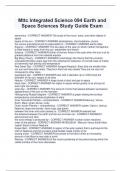
-
Mttc Integrated Science 094 Earth and Space Sciences Study Guide Exam
- Exam (elaborations) • 5 pages • 2024
-
Available in package deal
-
- $12.49
- + learn more
Mttc Integrated Science 094 Earth and Space Sciences Study Guide Exam astronomy - CORRECT ANSWER-The study of the moon, stars, and other objects in space layers of the sun - CORRECT ANSWER-photosphere, chromosphere, corona the moons gravitational pull is responsible for - CORRECT ANSWER-earths tides Equinox - CORRECT ANSWER-The two days of the year on which neither hemisphere is tilted toward or away from the sun; september and march Solstice - CORRECT ANSWER-Either of the two times o...
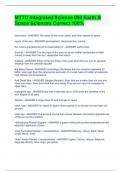
-
MTTC Integrated Science 094 Earth & Space Sciences Correct 100%
- Exam (elaborations) • 7 pages • 2024
-
Available in package deal
-
- $10.99
- + learn more
astronomy - ANSWER The study of the moon, stars, and other objects in space layers of the sun - ANSWER photosphere, chromosphere, corona the moons gravitational pull is responsible for - ANSWER earths tides Equinox - ANSWER The two days of the year on which neither hemisphere is tilted toward or away from the sun; september and march Solstice - ANSWER Either of the two times of the year when the sun is at its greatest distance from the celestial equator Big Bang Theory - ANSWER (c...
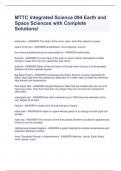
-
MTTC Integrated Science 094 Earth and Space Sciences with Complete Solutions!
- Exam (elaborations) • 7 pages • 2024
- Available in package deal
-
- $11.99
- + learn more
astronomy - ANSWER-The study of the moon, stars, and other objects in space layers of the sun - ANSWER-photosphere, chromosphere, corona the moons gravitational pull is responsible for - ANSWER-earths tides Equinox - ANSWER-The two days of the year on which neither hemisphere is tilted toward or away from the sun; september and march Solstice - ANSWER-Either of the two times of the year when the sun is at its greatest distance from the celestial equator Big Bang Theory - ANSWER-(c...
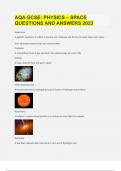
-
AQA GCSE PHYSICS – SPACE QUESTIONS AND ANSWERS 2023
- Exam (elaborations) • 4 pages • 2023
-
Available in package deal
-
- $14.99
- + learn more
Supernova A gigantic explosion in which a massive star collapses and throws its outer layers into space How elements heavier than iron were formed Protostar A contracting cloud of gas and dust; the earliest stage of a star's life Nebula A large cloud of dust and gas in space Main Sequence Star A normal star that is undergoing nuclear fusion of hydrogen into helium. Black Hole An object in space whose gravity is so strong not even light can escape. Red Giant A s...
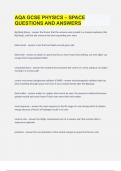
-
AQA GCSE PHYSICS – SPACE QUESTIONS AND ANSWERS.
- Exam (elaborations) • 2 pages • 2023
-
Available in package deal
-
- $14.99
- + learn more
Big Bang theory the theory that the universe was created in a massive explosion (the Big Bang), and that the universe has been expanding ever since black dwarf a star that has faded out and gone cold black hole an object in space that has so much mass that nothing, not even light, can escape from its gravitational field centripetal force the resultant force towards the centre of a circle acting on an object moving in a circular path cosmic microwave background rad...
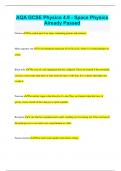
-
AQA GCSE Physics 4.8 - Space Physics Already Passed
- Exam (elaborations) • 4 pages • 2023
- Available in package deal
-
- $9.99
- + learn more
AQA GCSE Physics 4.8 - Space Physics Already Passed Nucleus The central part of an atom, containing protons and neutrons. Main sequence star A star during the main part of its life cycle, where it is using hydrogen as a fuel. Black hole The core of a red supergiant that has collapsed. These are formed if the remaining core has a mass more than three or four times the mass of the Sun. It is so dense that light can't escape it. Protostar The earliset stage in the lifecycle of a star They are f...
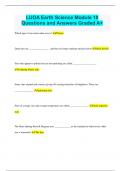
-
LUOA Earth Science Module 10 Questions and Answers Graded A+
- Exam (elaborations) • 5 pages • 2023
- Available in package deal
-
- $8.99
- + learn more
LUOA Earth Science Module 10 Questions and Answers Graded A+ Which type of star emits radio waves? Pulsars Dead stars are ________________ , and they no longer undergo nuclear fusion black dwarfs Stars that appear to pulsate but are non-pulsating are called ___________________. eclipsing binary stars Some stars expand and contract giving off varying intensities of brightness. These are _______________. pulsating stars Stars of average size and average temperature are called _______________. ...
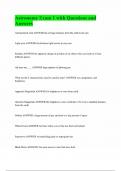
-
Astronomy Exam 1 with Questions and Answers
- Exam (elaborations) • 3 pages • 2024
-
Available in package deal
-
- $7.99
- + learn more
Astronomy Exam 1 with Questions and Answers Astronomical Unit ANSWER the average distance from the earth to the sun Light-year ANSWER the distance light travels in one year Parallax ANSWER the apparent change in position of an object when you look at it from different places All stars are____ ANSWER huge spheres of glowing gas What are the 3 characteristics used to classify stars? ANSWER size, temprature, and brightness Apparent Magnitude ANSWER it's brightness as seen from ...
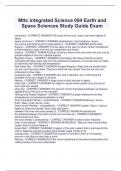
-
Mttc Integrated Science 094 Earth and Space Sciences Study Guide Exam
- Exam (elaborations) • 5 pages • 2024
- Available in package deal
-
- $12.49
- + learn more
Mttc Integrated Science 094 Earth and Space Sciences Study Guide Exam astronomy - CORRECT ANSWER-The study of the moon, stars, and other objects in space layers of the sun - CORRECT ANSWER-photosphere, chromosphere, corona the moons gravitational pull is responsible for - CORRECT ANSWER-earths tides Equinox - CORRECT ANSWER-The two days of the year on which neither hemisphere is tilted toward or away from the sun; september and march Solstice - CORRECT ANSWER-Either of the two times o...

Did you know that on average a seller on Stuvia earns $82 per month selling study resources? Hmm, hint, hint. Discover all about earning on Stuvia


